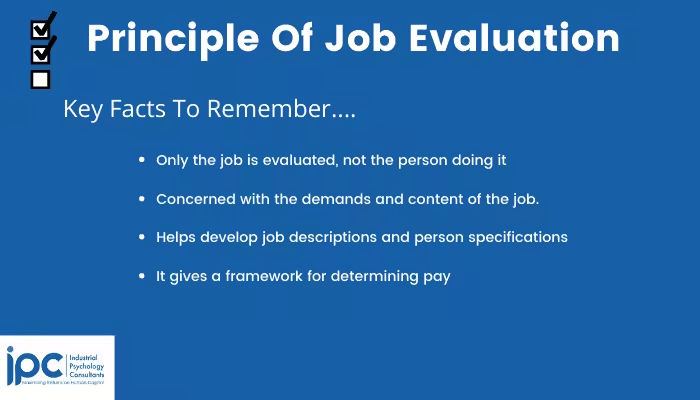What is Job Evaluation?

A job evaluation is a way of ascertaining the value and worth of a job when compared to other jobs in the company. A systematic comparison between jobs will be performed to find out their relative worth. This is done to come up with a rational and defendable pay structure. This is possible because a job evaluation does not evaluate the employee but the job, and considers current company systems and structure in place, as well as, any future plans that may come. Jobs are then judged as being “low” or “high” in comparison to other jobs in the company hierarchy. A job analysis, which is part of the job evaluation, is a process in which the duties and responsibilities of each job in a company are determined and clearly established. A job analysis is very important to a company’s recruitment and retention policy as it uncovers the qualifications and competencies necessary for each job. It produces job descriptions that detail minimum hiring standards for jobs. This goes a long way in ensuring companies seek out the right candidates for each job, limiting the need to keep returning to the job market after a new hire proves to have been mismatched with the job. It is vital that companies get this step correct, as the practice of hiring and subsequently replacing bad hires is a very expensive one. To uncover the conditions of work necessary and the key competencies relevant for each position, interviews with staff or surveys may be conducted.
What are compensable factors?
Compensable factors are the criteria used in evaluating a job and determining the salary level a particular job is due. They represent the aspects that a company values and are willing to pay for. Therefore, compensable factors are typically identified and classified based on the company’s values and culture.
Compensable Factor Examples
In an HR Daily Advisor article titled “10 Critical Compensable Factors in Job Descriptions”, Stephen Bruce identifies the following as being important to the job evaluation process:
- Experience. How long should the incumbent have worked in this job or in closely related jobs to be fully qualified? Is it important that the experience be within or outside the organization?
- Education. What does the job require in terms of formal schooling, training, certification, or knowledge of a specialized field?
- Responsibility. Is the employee responsible for the safety of other employees or the loss or damage to tools, materials, or equipment? How significant to the employer is the work the position is responsible for? How big is the budget the incumbent manages?
- The complexity of duties. Does the job require the incumbent to show judgment and initiative or to make independent decisions?
- Supervision received. How closely does the incumbent’s immediate supervisor or manager check his or her work? Does the supervisor or manager outline specific methods or work procedures?
- Supervision exercised. How many people does the incumbent supervise, directly and indirectly? What responsibility does he or she have for controlling policy decisions, costs, or work methods?
- Consequences of error. If the incumbent made an error, what dollar loss would be likely to result? How often does the possibility of loss or error occur?
- Working conditions. Is there anything in the work environment that is unusually hazardous or uncomfortable? For what percentage of the time is the incumbent exposed to such conditions?
- Mental, physical, and visual demands. What degree of concentration is required? Are there special physical demands? Is eyestrain likely?
- Confidential data. To what extent is the incumbent responsible for confidential information? What would be the consequences of unwarranted disclosure? To what extent are integrity and discretion important?
There are four broad compensable factors, as defined within the United States Equal Pay Act of 1963, under which most compensable factors fall. These four are:
- Skills, which encompass factors such as years of experience, level of education, and overall ability
- Responsibilities, which include the number of direct reports, fiscal accountability, and the list of responsibilities of the position itself
- Mental and physical effort, which includes factors such as degree and amount of concentration, level, and frequency of physical effort
- Working conditions, which consider environmental factors such as location, hazards, and any extreme factors
Related: How to Manage a Job Evaluation Project
Characteristics of appropriate compensable factors
When selecting compensable factors to use in job evaluation, the Economic Research Institute identifies the following 7 characteristics that need to be satisfied for the factors to be effective:
- “They must be present in all jobs.
- They need to be definable and measurable.
- The factor must vary in degree. A factor found in equal amounts in all jobs would be worthless as a basis of comparison.
- If two or more factors are chosen, they should not overlap in meaning. If they do overlap, double weight may be given to one factor.
- Employer, employee, and union viewpoints should be reflected in the factors chosen; consideration of all viewpoints is critical for acceptance.
- Compensable factors must be demonstrably derived from the work performed. The factors must be observable in the jobs. For this reason, responsibility is a hard factor to use. Compensable factors can be thought of as the job-related contributions of employees. Documentation of the work-relatedness of factors comes from job descriptions. Such documentation provides evidence against allegations of illegal pay discrimination. It also provides answers to employees, managers, and union leaders who raise questions about differences among jobs.
- Compensable factors need to fit the organization. Organizations design jobs to meet their goals and to fit their technology, culture, and values.”
Methods used in determining compensable factors
The Economic Research Institute further provides three common ways in which appropriate compensable factors can be determined.
Standard job evaluation plans
Many organisations adopt standard job evaluation plans and thus the factors on which they are based are predetermined. Most organisations that do this, adjust existing plans to their own requirements. The factors in most existing plans tend to fall into the four broad categories outlined earlier. These factors are used in numerous job evaluation plans.
Group process method
Through a group process approach, companies may build their own collection of factors. This approach involves bringing together a group of skilled individuals who know a great deal about the jobs being evaluated. These individuals are requested to review the job descriptions of a selected group of key jobs and to list all the job attributes, criteria, and conditions that should, in their opinion, be taken into account in the job evaluation. The group must then come up with job attributes, which are then put into a particular classification.
Statistical methods
It is possible to determine compensable factors using statistical methods. Statistical techniques can serve to ensure that the proposed factors are actually related and relevant to the job, as well as, legally defensible. However, it is important to note that employees may not view some statistically determined factors as being relevant to their jobs. While the statistical approach is capable of evaluating how reliably the factors assess the jobs, it may not be financially or technically possible for all organisations to perform such analyses.
The following steps are to establish a statistically validated job evaluation:
- Develop and administer a structured questionnaire that can be computerized on a sample of key jobs.
- Develop and gather data for a dependent variable.
- Develop and test a multiple regression model on the benchmark jobs.
- Make any required revisions and gather data from remaining jobs and apply the model to the entire organisation.
As discussed, compensable factors can give an outsider a peek into the aspects that a company values and is willing to pay for. It is thus important to ensure that careful consideration is given to them to ensure the right message is conveyed.
Nyasha Mukechi is a Business Analytics Consultant at Industrial Psychology Consultants (Pvt.) Ltd; a management and human resources consulting firm.
Phone +263 4 481946-48/481950 or
email: nyasham@ipcconsultants.com or
visit our website at www.ipcconsultants.com

